Tyson Foods Bundle
How did a chicken delivery service become a global food empire?
Journey back to 1935 and discover the Tyson Foods SWOT Analysis, a company that began during the Great Depression with a simple mission: deliver quality chicken. From its humble origins in Springdale, Arkansas, to its current status as a multinational food corporation, Tyson Foods' story is one of remarkable growth and adaptation. Explore the fascinating Tyson Company History and uncover the key milestones that shaped this industry giant.
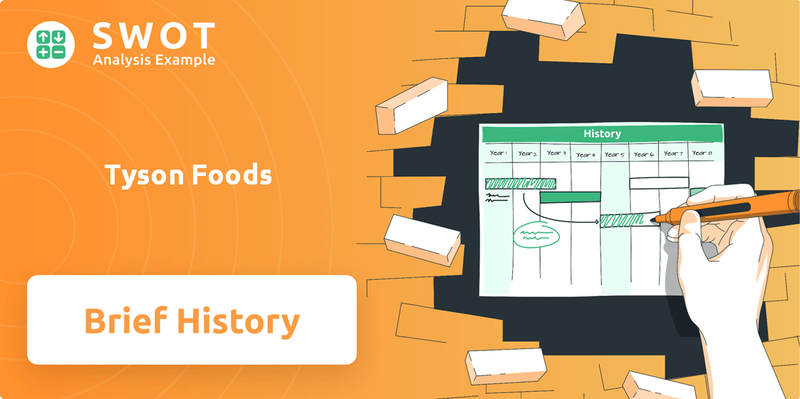
This article delves deep into the brief history of Tyson Foods, examining its origins with John Tyson and its expansion. We'll explore the early history of Tyson Foods company, including its strategic acquisitions and innovations. Learn about the company's impact on the food industry and its role in the American diet, providing a detailed Tyson Foods Timeline.
What is the Tyson Foods Founding Story?
The story of Tyson Foods began in 1935, a time of economic hardship and shifting opportunities. John W. Tyson, the company's founder, saw potential in the poultry market, a sector poised for growth in the wake of the fruit industry's decline in Northwest Arkansas. This marked the start of what would become a global food industry giant.
John W. Tyson, seeking new ventures, relocated his family to Springdale, Arkansas, in 1931. His entrepreneurial spirit led him to acquire a truck, setting the stage for his poultry business. This venture would evolve from a small-scale operation into a vertically integrated powerhouse, forever changing the landscape of the meat industry.
The early days of Tyson Foods were characterized by resourcefulness and a focus on meeting market demands. John W. Tyson's initial investment involved purchasing a truck on credit, which he used to transport and sell chickens. This early success laid the groundwork for the company's expansion and its eventual dominance in the poultry sector.
John W. Tyson's initial venture involved hauling chickens to markets like Kansas City and St. Louis, Missouri. His first trip to Chicago generated a profit of $235, which encouraged him to pursue poultry shipping full-time.
- The business model initially focused on selling baby chicks, feed, and transporting chickens.
- In 1947, John incorporated his business as Tyson Feed and Hatchery, Inc.
- A key challenge was the shortage of baby chicks, which led to establishing a hatchery and feed business.
- The company's initial operations were primarily funded through personal savings and bootstrapping efforts.
Tyson Foods SWOT Analysis
- Complete SWOT Breakdown
- Fully Customizable
- Editable in Excel & Word
- Professional Formatting
- Investor-Ready Format
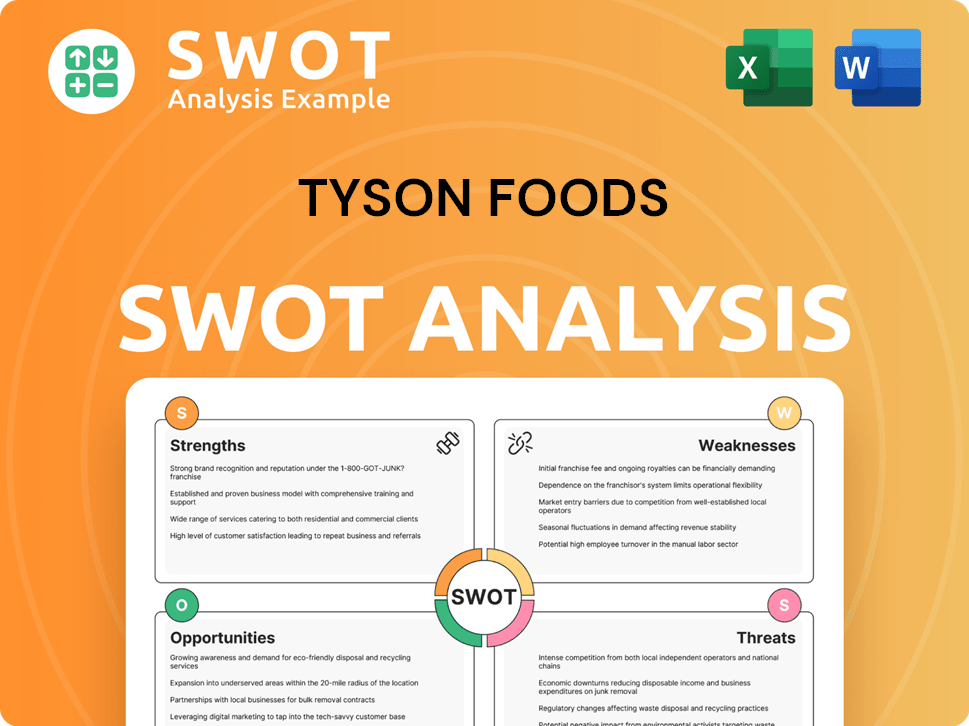
What Drove the Early Growth of Tyson Foods?
The early growth and expansion of Tyson Foods, a pivotal period in its history, was marked by strategic decisions and significant market shifts. This phase saw the company capitalize on opportunities, particularly during World War II, and lay the groundwork for its future dominance in the food industry. The company's commitment to vertical integration and strategic acquisitions played a crucial role in its rapid growth.
The Marketing Strategy of Tyson Foods began with its founder, John Tyson, who started the company. In the 1940s, Tyson Foods expanded its operations by integrating vertically, starting with hatching chicks and grinding feed. This strategy allowed the company to control both the quality and cost of its supply chain, a key factor in its early success.
In 1952, John's son, Don Tyson, joined the company as general manager, and his leadership was pivotal. A major turning point occurred in the late 1950s when Don Tyson spearheaded the construction of the company's processing plant. This move was crucial after a deal with another processing company fell through, showcasing the company's independent spirit.
In 1963, the company went public as Tyson's Foods, Inc., which was a strategic move to raise capital. This allowed for significant expansion, including its first acquisition, Garrett Poultry Company. Don Tyson became president in 1966, and under his leadership, the company adopted an aggressive acquisition strategy.
By 1970, Tyson's debuted on the Fortune 1000 list, and in 1971, it officially changed its name to Tyson Foods. The 1970s and 1980s saw continued expansion into new markets, including the acquisition of major hog-producing facilities in North Carolina in 1977, making Tyson the nation's largest hog producer. In 1982, the company debuted on the Fortune 500 list. A significant milestone was the acquisition of Holly Farms in 1989, which nearly doubled Tyson's market share.
Tyson Foods PESTLE Analysis
- Covers All 6 PESTLE Categories
- No Research Needed – Save Hours of Work
- Built by Experts, Trusted by Consultants
- Instant Download, Ready to Use
- 100% Editable, Fully Customizable
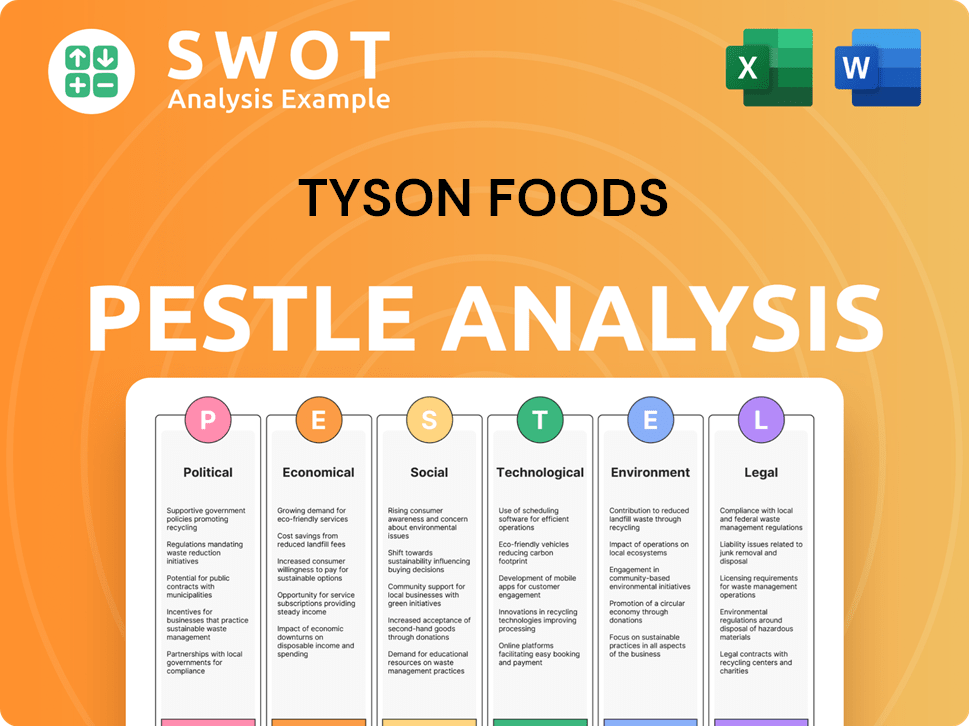
What are the key Milestones in Tyson Foods history?
The history of Tyson Foods is marked by significant milestones that have shaped its trajectory in the food industry. From its humble beginnings, the company has grown into a global leader, achieving key acquisitions and innovations that have expanded its market presence and product offerings. Understanding the Tyson Company History is crucial to grasping its current position and future prospects.
| Year | Milestone |
|---|---|
| 1935 | John W. Tyson founded the company, starting with a small poultry business. |
| 2001 | Acquired IBP, Inc. for $3.2 billion, becoming the world's largest processor and marketer of chicken, beef, and pork. |
| 2014 | Acquired Hillshire Brands, expanding its prepared foods portfolio. |
Innovation has been a cornerstone of Tyson Foods's success. The company has consistently invested in research and development to improve its products and processes. The Discovery Center, completed in 2007, has served as a hub for innovation, driving advancements in the industry.
Expanding beyond poultry, Tyson has diversified its product lines to include beef, pork, and prepared foods. This diversification has helped the company to navigate market fluctuations.
Tyson has implemented advanced technologies and automation to improve efficiency in its processing plants. These improvements have led to cost savings and increased production volumes.
The company has invested in sustainable practices, including reducing its environmental footprint and promoting animal welfare. These initiatives are becoming increasingly important to consumers.
Tyson is leveraging data and digital technologies to optimize its supply chain and improve decision-making. This includes using data analytics to predict demand and manage inventory more effectively.
Significant investment in automation has increased processing speeds and reduced labor costs. This has improved overall efficiency and profitability.
Ongoing investment in research and development has led to new product innovations and improvements in existing products. This includes developing new flavors and healthier options.
Despite its successes, Tyson Foods has faced several challenges. Market downturns, competitive pressures, and rising costs have impacted its financial performance. The company's beef segment, for example, has experienced headwinds due to elevated cattle costs.
Elevated cattle costs have compressed margins in the beef segment, impacting profitability. While beef sales grew 4.9% year-over-year in Q2 2025, adjusted operating income declined.
Legal contingency accruals have reduced sales, impacting overall financial performance. In Q2 2025, these accruals reduced sales by $343 million.
Fluctuations in commodity prices and consumer demand have created market volatility. This requires Tyson to adapt quickly to changing conditions.
Intense competition within the food industry puts pressure on pricing and market share. Tyson must continuously innovate and improve to stay competitive.
Disruptions in the supply chain, including labor shortages and transportation issues, have impacted production and costs. These disruptions require proactive management.
Evolving consumer preferences, such as demand for healthier and more sustainable products, require Tyson to adapt its product offerings and strategies. This includes developing new product lines and marketing campaigns.
Tyson Foods Business Model Canvas
- Complete 9-Block Business Model Canvas
- Effortlessly Communicate Your Business Strategy
- Investor-Ready BMC Format
- 100% Editable and Customizable
- Clear and Structured Layout
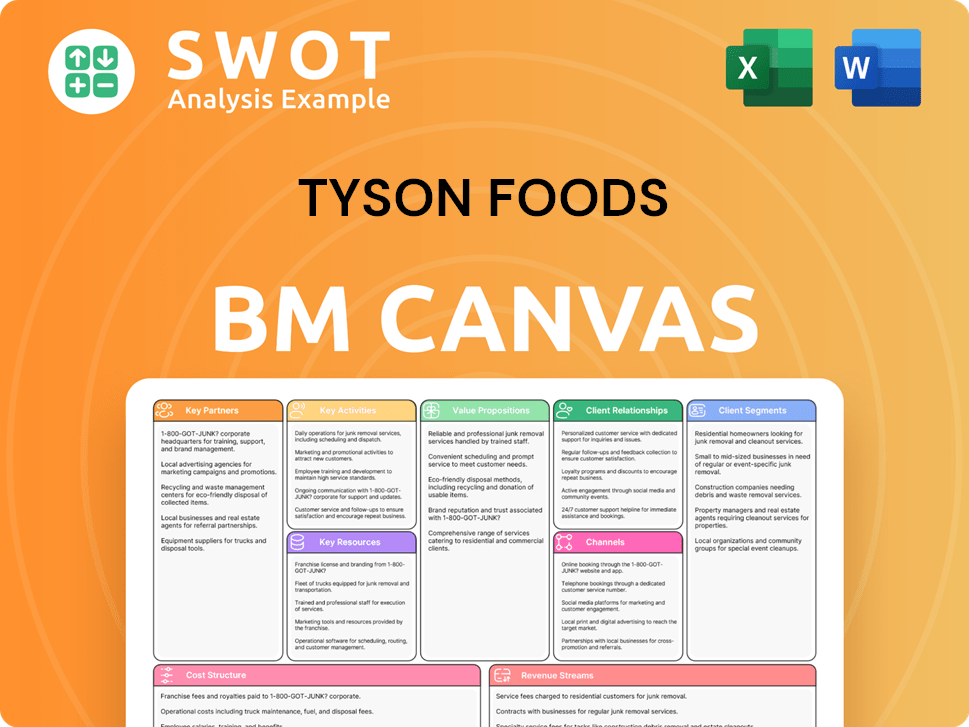
What is the Timeline of Key Events for Tyson Foods?
The Tyson Company History began in 1935 when John W. Tyson started the company, initially focused on delivering chickens. Over the years, it evolved from a small operation to a global food industry leader. Key milestones include the 1957 opening of the first processing plant, the 1963 public offering, and the 2001 acquisition of IBP, Inc., which solidified its position as a major player in the meat processing industry. The company has consistently expanded its operations and product offerings through strategic acquisitions and organic growth, adapting to market demands and consumer preferences.
| Year | Key Event |
|---|---|
| 1935 | John W. Tyson founded the company, starting with chicken delivery. |
| 1947 | Tyson Feed and Hatchery, Inc. was incorporated. |
| 1957 | The first processing plant opened in Springdale, Arkansas. |
| 1963 | The company went public as Tyson's Foods, Inc. |
| 1966 | Don Tyson became company president. |
| 1971 | The company name officially changed to Tyson Foods. |
| 1977 | Tyson became the nation's largest hog producer. |
| 1982 | Tyson debuted on the Fortune 500 list. |
| 1989 | Acquisition of Holly Farms expanded poultry operations. |
| 2001 | Acquisition of IBP, Inc. made Tyson the world's largest processor of chicken, beef, and pork. |
| 2014 | Acquisition of Hillshire Brands diversified the product range. |
| 2020 | Dean Banks became CEO. |
| 2021 | Donnie King became President and CEO. |
| 2024 | Total revenue reached $53.31 billion. |
| 2025 (Q2) | Reports adjusted EPS of $0.92, up 48% year-over-year. |
For fiscal year 2025, Tyson Foods anticipates total adjusted operating income to be between $1.9 billion and $2.3 billion. Sales are expected to remain flat to increase by 1% compared to fiscal year 2024. The company projects capital expenditures to be between $1.0 billion and $1.2 billion, focusing on profit improvement projects.
Tyson Foods is committed to achieving net-zero greenhouse gas emissions by 2050. By 2030, the company plans to increase renewable energy usage in U.S. operations to 50% and eliminate deforestation risk. They also aim to expand sustainable beef production practices across 5 million acres of grazing lands by 2025.
The company expects its adjusted effective tax rate to be approximately 25% for fiscal year 2025. Net interest expense is projected to be around $375 million. These financial targets are part of Tyson Foods' strategy to maintain profitability and drive long-term shareholder value.
Tyson Foods is concentrating on operational excellence and long-term value creation. The company's strategic initiatives include investments in sustainability and expanding sustainable beef production. These efforts align with its foundational vision of providing quality food while adapting to market changes and environmental responsibilities.
Tyson Foods Porter's Five Forces Analysis
- Covers All 5 Competitive Forces in Detail
- Structured for Consultants, Students, and Founders
- 100% Editable in Microsoft Word & Excel
- Instant Digital Download – Use Immediately
- Compatible with Mac & PC – Fully Unlocked
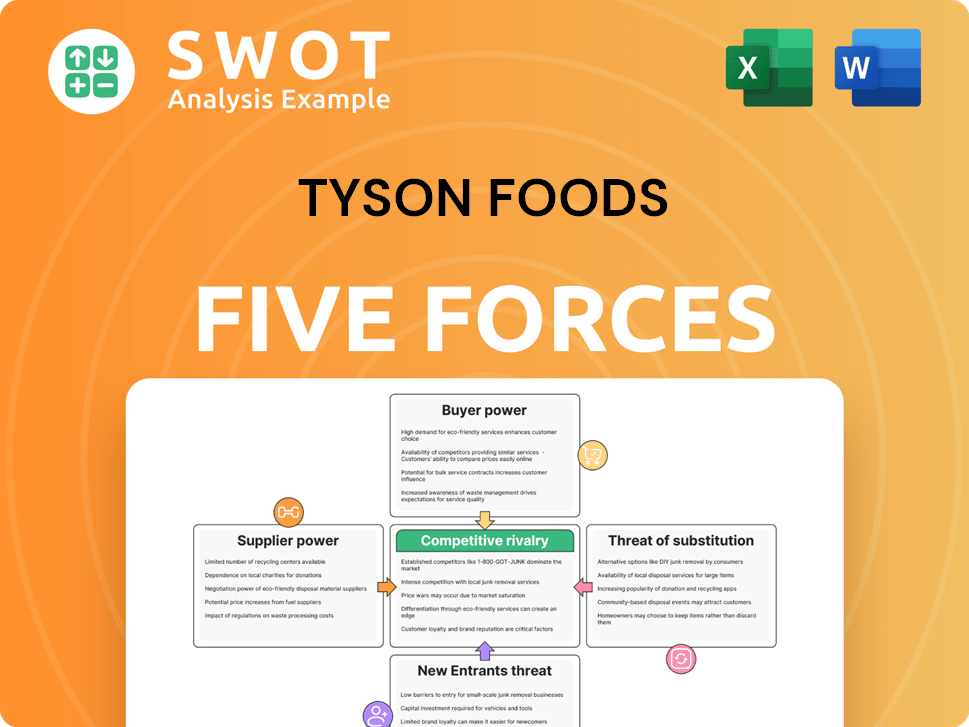
Related Blogs
- What is Competitive Landscape of Tyson Foods Company?
- What is Growth Strategy and Future Prospects of Tyson Foods Company?
- How Does Tyson Foods Company Work?
- What is Sales and Marketing Strategy of Tyson Foods Company?
- What is Brief History of Tyson Foods Company?
- Who Owns Tyson Foods Company?
- What is Customer Demographics and Target Market of Tyson Foods Company?
Disclaimer
All information, articles, and product details provided on this website are for general informational and educational purposes only. We do not claim any ownership over, nor do we intend to infringe upon, any trademarks, copyrights, logos, brand names, or other intellectual property mentioned or depicted on this site. Such intellectual property remains the property of its respective owners, and any references here are made solely for identification or informational purposes, without implying any affiliation, endorsement, or partnership.
We make no representations or warranties, express or implied, regarding the accuracy, completeness, or suitability of any content or products presented. Nothing on this website should be construed as legal, tax, investment, financial, medical, or other professional advice. In addition, no part of this site—including articles or product references—constitutes a solicitation, recommendation, endorsement, advertisement, or offer to buy or sell any securities, franchises, or other financial instruments, particularly in jurisdictions where such activity would be unlawful.
All content is of a general nature and may not address the specific circumstances of any individual or entity. It is not a substitute for professional advice or services. Any actions you take based on the information provided here are strictly at your own risk. You accept full responsibility for any decisions or outcomes arising from your use of this website and agree to release us from any liability in connection with your use of, or reliance upon, the content or products found herein.